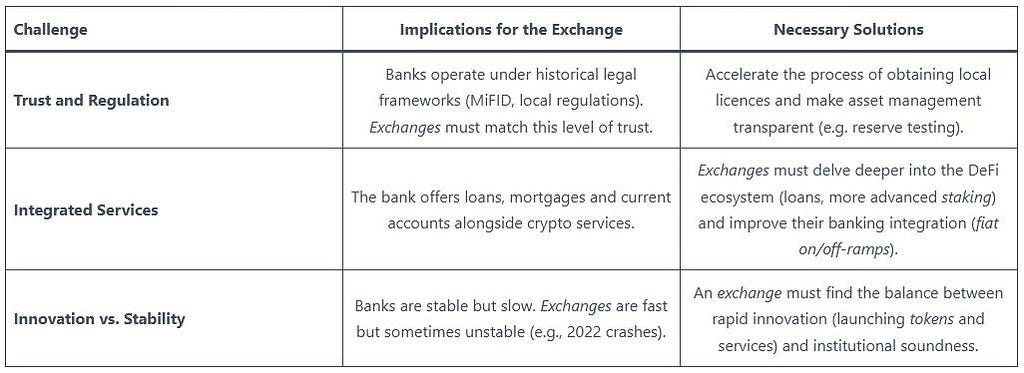


1
0

BANKING VS. EXCHANGES — For years, the relationship between traditional banking (TradFi) and cryptocurrency exchanges (CeFi/CEX) has been awkward at best. Banks viewed cryptocurrencies as a regulatory and business threat, while exchanges represented financial freedom.

However, the approval of listed products (such as Bitcoin and Ethereum ETFs) has marked a turning point. Institutional capital is flowing in, and banks can no longer afford to be mere spectators. Today, banks are not just custodians and facilitators; they are becoming direct rivals to exchanges, using their historical advantage and, above all, their customer information.
This article analyses how this new rivalry is developing and the challenge it poses for exchange platforms:
1. The Institutional Landfall: Banking Knocks on Crypto’s Door
The entry of banks into the crypto world is a multifaceted phenomenon, driven by two main factors:
This integration means that customers see cryptocurrency not as a radical asset, but as just another asset class, accessible from their own banking app, undermining the ‘ease’ advantage that exchanges previously offered.
2. Information Asymmetry: The Secret Weapon of Banks
Herein lies the key to the new competition: banks have access to their customers’ transaction data, an advantage that exchanges do not have in reverse.
Every time a traditional bank customer transfers fiat money to an exchange (such as Binance, Kraken or Coinbase), the bank records this action.
3. The Challenge for Exchanges: Adapt or Lose Market Share
This onslaught by banks is forcing centralised exchanges to redefine their value proposition. Their main challenges are:


The rivalry between banks and exchanges is excellent news for consumers, as it drives service improvements, lower costs and, above all, regulatory transparency.
For customers, the decision will focus on choosing between:
In this new landscape, the survival of exchanges will depend on their ability not only to compete on price, but also to offer a superior user experience and regulatory transparency that meets the growing demands of institutional and retail customers.
Disclaimer: The information set forth herein should not be taken as financial advice or investment recommendation. All investments and trading involve risk and it is the responsibility of each individual to do his or her due diligence before making a decision.
1
0
 Manage all your crypto, NFT and DeFi from one place
Manage all your crypto, NFT and DeFi from one placeSecurely connect the portfolio you’re using to start.